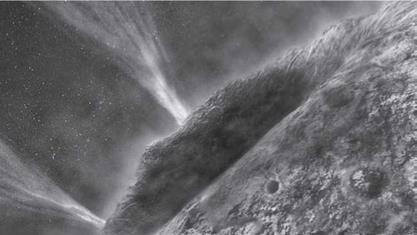Stardust Surprises
Stardust had some surprises in store for scientists working on the mission.20 The first came during the flyby. Team members and comet experts expected Wild 2 to be bland-l ooking, like a large black potato. Instead, the seventy-two images sent back to Earth revealed a dramatic scene (figure 6.3). There were kilometer-sized holes bounded by vertical and sometimes overhanging cliffs, spiky pinnacles hundreds of meters high, and numerous jets of gas and dust surging into space. Some of the holes didn’t look like the kind of impact crater found on Mercury, the Moon, and every other airless surface exposed to space. The ravines and chasms indicated that the surface is very young and is constantly being created and altered by dynamic processes within the comet. Some of the jets were on the dark side of the comet, proving that they are not generated by the action of the Sun. Wild 2 doesn’t look like any other comet or asteroid that’s been imaged by spacecraft (plate 10).
A related surprise came as the spacecraft flew through debris escaping from the comet. It was expected that the rate of particle hits would increase with time, reach a smooth peak, and then decline as the comet rapidly disappeared in the rearview mirror. Instead, the impact rate surged and fell in bursts, presumably as the spacecraft passed through jets of dust escaping from the surface and the breakup of cometary “clods” as the ice holding them together evaporated.21
The most exciting discovery came in 2009, when a team at Goddard Space Flight Center reported the discovery of the amino acid glycine in tiny particles they were analyzing.22 It’s not a total surprise that comets contain molecules like amino acids, but their survival intact in material traveling at thousands of miles per hour was unexpected. An isotopic study of the glycine showed it was not a contaminant from Earth. This discovery shows that at least
|
Figure 6.3. An artist’s concept of the comet Wild 2, as seen by the Stardust spacecraft during its close approach. As it nears the Sun, the comet becomes active and releases jets of hot gases and clumps of material into space. Its surface is etched with steep canyons and dramatic valleys, all on an object the size of a small town on Earth (NASA/Jet Propulsion Laboratory). |
one of the essential ingredients for life can be delivered by comets, and since most stars are thought to have comet clouds, comets will be an important delivery system for delivering pre-biotic molecules to Earth-like planets, so “setting the table” for life. Another unexpected result was the discovery of iron and copper sulfide minerals in Wild 2 that could only have formed in the presence of water.23 This means that the comet has spent some of its time at balmy temperatures in the range 50-200°C, where water is liquid or steam, so it’s not the “frozen snowball” that everyone expected.
Often in science, a simple model or theory formed based on limited data has to be modified or even discarded when better data are gathered. Nature is messier than our wishful thinking. The Stardust mission has played an important role in retooling the conventional ideas of comet structure and formation mechanisms. It was long thought that short-period comets formed from materials that condensed beyond the orbit of Neptune in the cold Kui – per Belt. Long-period comets, by contrast, were presumed to have formed at higher temperatures closer to the Sun, among the giant planets, and then subsequently ejected (primarily by the gravity of Jupiter) to orbits that extend halfway to the nearest star. The discovery of trans-Neptunian objects that feed both the short – and the long-period comet population complicates this simple picture. Data from Stardust have complicated it further.
Our direct information on comets is still modest. The first probe to reach a comet was launched in 1978 and approached Comet Giacobini-Zinner, providing support for the “dirty snowball” theory. Comet Halley’s first visit to the inner Solar System in the age of spacecraft was in 1986, and received visits from an armada of spacecraft—Giotto, Suisei, Sakigake, Vega 1, and Vega 2. Fifteen years later, Deep Space 1 flew by comet Borrelly. Stardust came next, and in 2005, Deep Impact excavated 10,000 tons of material from comet Tempel 1 by smashing into it at 23,000 mph. When Stardust returned its payload in 2006, it was the first time we had gathered physical samples from any other place than the Moon. As the only human relic to go on a multi-billion-mile journey and return home, Stardust earned a very auspicious resting place. In 2008, on NASA’s fiftieth anniversary, the sample return capsule went on display in the Smithsonian Museum’s “Milestones of Flight” gallery, alongside iconic artifacts such as the Apollo 11 command module, Charles Lindbergh’s “Spirit of St. Louis,” and the Wright brothers’ 1903 Flyer.











